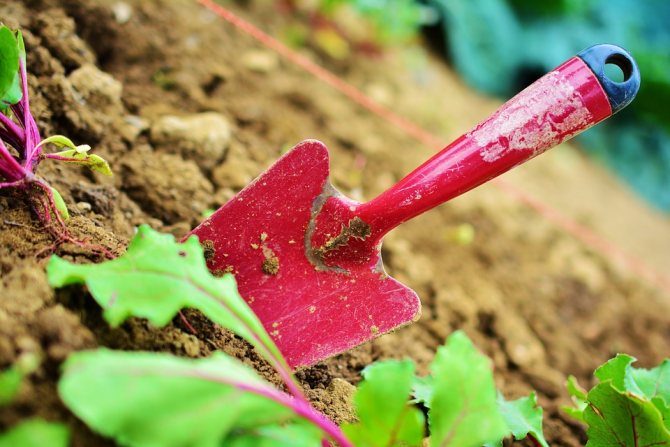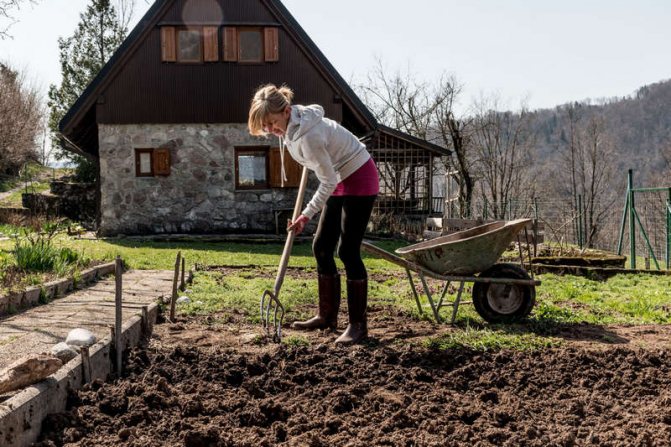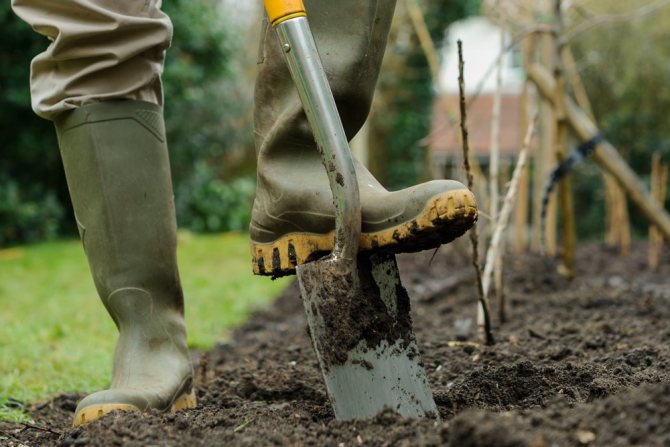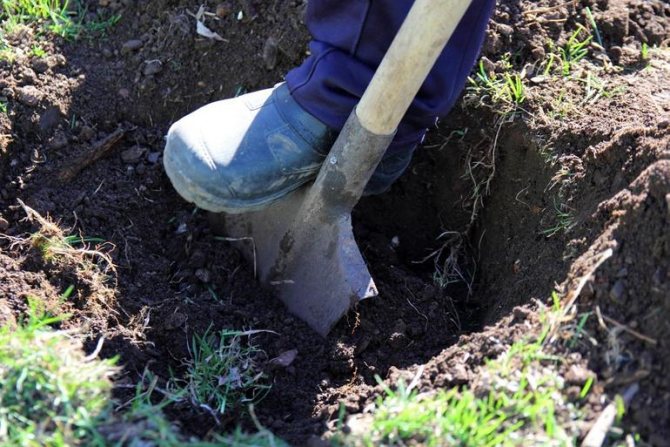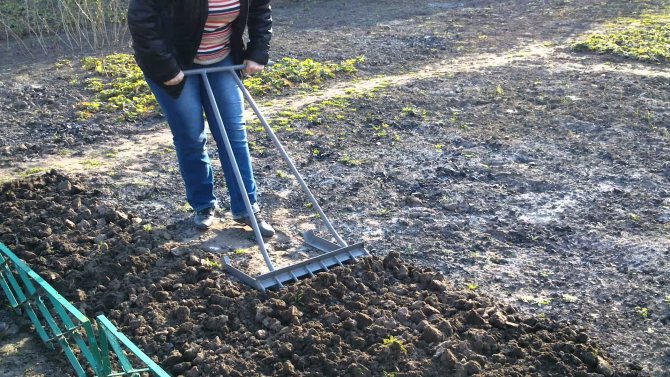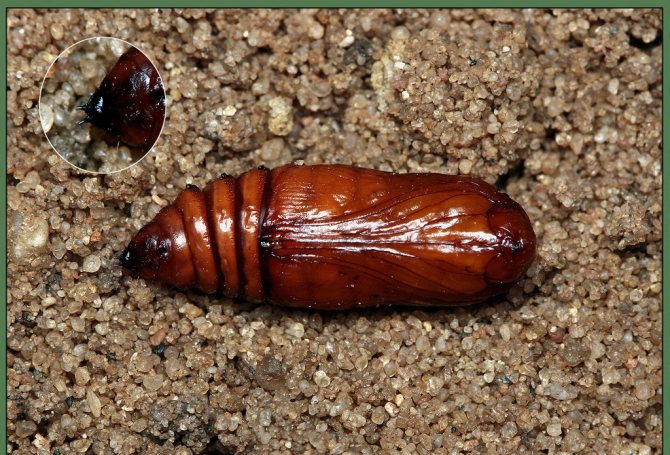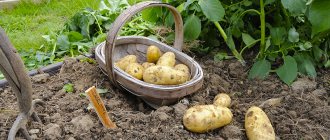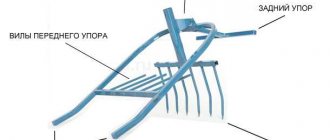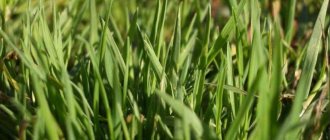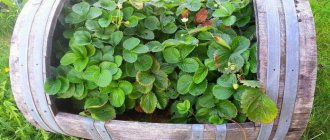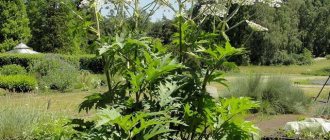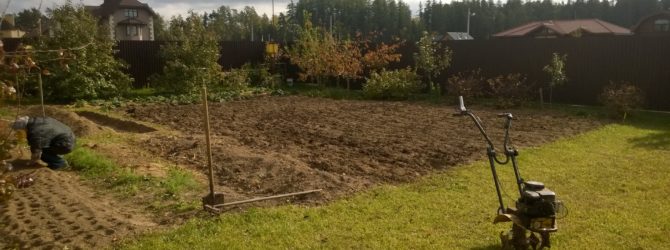
The season is drawing to a close and a good harvest has been gathered. In summer, only the leek bed is green, waiting for the first frost. And the most eternal, controversial and, it seems, unanswered question arises ... I don't know how anyone has it, but I have a garden before winter dug up on the bayonet of the shovel. The debate has not ended for a long time: whether to dig or don't dig? I want to express my opinion.
In the Oryol region, we need to dig up land before winter. After all, we are in a zone of not the most favorable agriculture, and our ancestors always did this not because they had nothing to do in the fall. But, dear summer residents and gardeners, digging is not just a duty, as some believe: like I gathered a crop, shoveled the earth in September - and goodbye until spring.
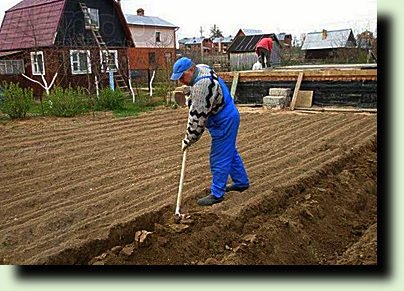

Digging is an important agronomic technique; it was not in vain that the fields were plowed before winter. But they plowed with the introduction of organic fertilizers after prolonged autumn rains and even after the first autumn frosts, in the frost! Late plowing is both the fight against weeds and pests, and the retention of moisture and snow in the summer cottage. It is advisable not to dig bare earth. I do the following.
After harvesting potatoes in August (I have early varieties - Vesna, Rosara, Adretta), the land on the site is leveled and slightly harrowed. In the 20th, I sow mustard (you can add oats, barley, if available). The plot is well harrowed with a rake and, if there is no rain, I water it. The mustard rises and grows before flowering, after which it is mowed, leveled over the site and lies before digging. A drop from apples is collected and poured onto the mustard.


Further: I collected the last tomatoes - I can't stand tops from the site. I cut it to the root with a pruner, cut it right there into pieces of 10 cm, distribute it evenly over the area. The root remains in the ground. I do the same with pepper and eggplants.
—- Plowing for plowing was widely used both before the revolution and in Soviet times. Agronomists singled out three of its advantages: - a significant increase in productivity; - one less laborious work in spring; - the possibility of super early sowing.
I dug up the carrots, cut off the tops, removed the roots. I spread the tops of the tops evenly right there, in the garden bed. I do the same with beets. He chopped the cabbage, left the stumps and leaves in the garden, chopped them with a shovel, and evenly spread them out. With zucchini - the same. I collected the beans, chopped the stems with an ax - and back to the garden. I collect the fallen leaves, leave some of them for shelter of grapes and warm beds, and take the rest to the area where there were tomatoes, onions, cucumbers, peppers, eggplants. The plot is, as it were, covered with a kind of "blanket" and is ready for digging.
After October 25, having sharpened the shovel well, I start digging. By this time, as a rule, strong, abundant autumn rains pass, the earth is saturated with moisture, it is well cut. Even if there are first frosts, they do not interfere: the "fur coat" does not allow the ground to freeze.
Digging with a full bayonet with a land flip. The bed width is 8-10 cm, no more. All mulch goes to a depth of 10-15 cm and quickly decays. Weeds, new grass from fallen seeds die, since there are no plants that grow with their roots up. Everything. The earth leaves in the winter lumpy, which means that the retention of snow and moisture is ensured. Undigged areas by this time look just miserable. And in the spring I don't dig the site.As the soil dries up, land the harrow, but not too shallow. At the same time, moisture is retained and weed sprouts that have hatched from overwintered seeds are killed.
On plots intended for planting tomatoes, peppers, eggplants, cabbage, I sow mustard. I plant seedlings directly in mustard - it protects from cold, wind and prevents the soil from drying out. Then the mustard is chopped with a hoe, and the green meadow turns into even beds of tomatoes and peppers.
I don't dig beds for planting carrots, beets, onions. I loosen the ground to a depth of 10 cm with a large hoe, then with a rake. I plant potatoes directly in the harrowed soil, depending on the weather and soil condition, usually on April 25-30.
In my opinion, the advantages of the autumn digging are obvious:
• improvement of soil structure, • moisture retention, • destruction of weeds and pests, • saving precious time for planting (spring digging is not necessary). Author; Alexander Vyacheslavovich LEPISHKO. Mtsensk, Oryol region w.m.p.d.1013
Experienced gardeners and gardeners know whether it is necessary to dig up the ground in the fall in the garden: the rules for digging. Working on the ground requires a responsible approach and before deciding how to till the soil, you should find out the advantages and disadvantages of this method. Thanks to digging, the soil can be filled with mineral, organic fertilizers, loosened. In the process, it is possible to remove the weeds. There are also opponents of digging a vegetable garden. Their reasons should also be taken into account.
Digging land for the winter
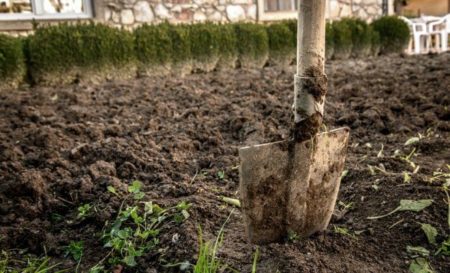

Digging a vegetable garden in the fall for the coming winter is imperative. This procedure is necessary to prepare the soil. In the autumn season, during the digging period, the ideal period for fertilizing with manure, compost and humus comes. Also, in farms where the planted crops are regularly affected by the Colorado potato beetle, bear, wireworm and other types of pests, digging the soil will be relevant. The procedure allows you to destroy the larvae hidden in the soil. For this, the soil is plowed to a depth of 25 cm.
What gives the cultivation of the land in autumn
Each gardener, gardener has a separate opinion whether it is necessary to dig up your garden in the fall. Not everyone knows why the earth is being dug. Some refuse this procedure, while others, on the contrary, completely process their land plot. You must first study the advantages and disadvantages of this procedure, and then decide whether you need to dig up the ground in the fall in your garden. Tips from experienced gardeners will help you understand the intricacies of digging.
Pros and cons of digging
The main advantage of the procedure is the ability to cultivate the site, enrich it with mineral, organic substances, and loosen the soil. In addition, it is an excellent method of weed control, which germinates well in warm autumn. The disadvantages of plowing must not be forgotten. The procedure is quite difficult, it takes a lot of time and effort. No need to dig in areas where it is not required.
The earth is home to a large number of worms, spiders, various microorganisms and fungi. Under a microscope, even a small piece can be seen billions of living microorganisms. They live at different depths. During the opening and turning of the soil, the locals change places, some die.
Weed control
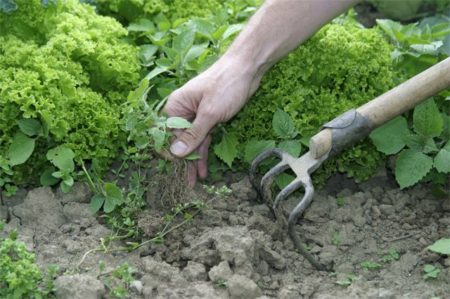

Weed control by weeding even in a small area is time consuming. Digging fertile soil helps to effectively control weeds. However, it should be borne in mind that it will not be possible to completely get rid of them, but plowing the site will significantly weaken the development of the weed.
In addition, in addition to weed seeds, fungi and other pathogenic bacteria will appear on the soil surface, which infect crops grown in the garden. Since cold snaps begin in the fall, all microorganisms will die at low temperatures.Therefore, digging soil in the garden is the best way to decontaminate it.
Fertilization and soil deoxidation
The enrichment of the soil with nutrients and the deoxidation procedure requires mixing it. This can only be done by digging up the ground. It is better to introduce ash into the soil, to fight weeds and their seeds with a shovel. Only a shovel ensures high-quality processing of a land plot, of course, if it does not occupy a large area. In other cases, you will have to spend money on shovel replacements, plowing with equipment adapted for this.
Do I need digging in the garden
It is imperative to plow your garden in the fall, but you need to resort to such a procedure on the garden plot with the utmost care. Many gardeners mistakenly plow the tree trunk with a shovel, because this is the most dangerous procedure for him. It helps to destroy the smallest roots. Therefore, it is not recommended to dig a garden for the coming winter. You can only slightly loosen the surface with a hoe.
Autumn digging of land with fertilization
There is a traditional opinion among gardeners that it is best to simultaneously add organic matter, up to manure, when digging a plot in autumn. Others suggest combining this with the introduction of mineral fertilizers. Still others assure that by rational selection of a wide range of mineral fertilizers for certain types of crops, it is possible to completely exclude the introduction of manure-humus.
Digging land in the fall with the introduction of manure
Manure as an organic fertilizer is historically recognized as a means of achieving high yields of most agricultural and dacha crops, it contributes to the structuring of the soil, improving its humus value, but it is not an absolute means of its fertility. It is not always possible to acquire such organics, unloading, overloading and the process of introducing it is quite laborious, and a lot of weed seeds are brought into the site with it. Correctly selected mineral fertilizers can completely make up for its absence and it is easier and easier to use them. In addition, a number of liquid or paste-like microbiological fertilizers are on sale nowadays, which have proven themselves well in gardening practice.
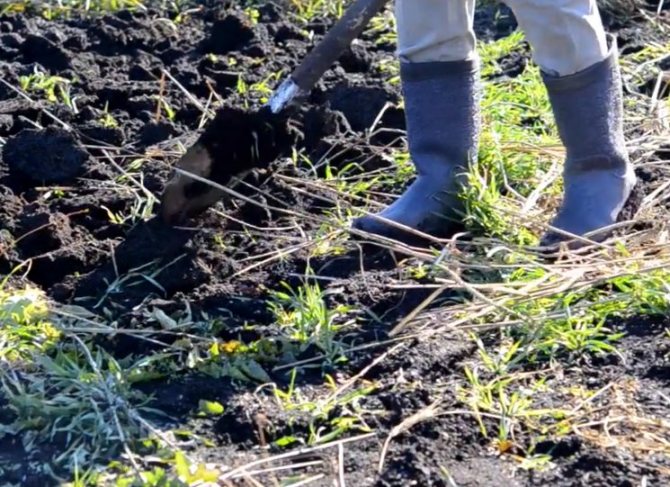

Before applying for digging the earth in the country in the fall, it is better to combine manure with grated eggshells, rotten straw (hay is rich in weeds), fallen leaves, ash, compost, chicken droppings, ash and even river sand. They can be introduced individually or as a mixture, taking into account, again, the requests of future plants on pre-planned beds and the level of acidity of the soil.
Digging land in the fall with the introduction of mineral fertilizers
The introduction of mineral fertilizers when digging land in the fall in the country requires caution and an agrotechnical approach so as not to harm future plants. When applying the mineral range of fertilizers, one should take into account the layout of the beds for the future harvest, because different crops prefer a set of minerals and trace elements that suits them. Certain crops, in addition to nitrogen, phosphorus, potassium, calcium, need boron, iron, magnesium, manganese and copper, with a deficiency of which some plant species will simply stop growing.
When digging land in the country in the fall, it is advisable to apply hardly soluble mineral fertilizers with the expectation that they will not lose their effectiveness until spring, but are activated with melting snow or spring precipitation.
Superphosphate (with fluff) and potassium chloride are suitable for vegetables. After loosening, sprinkle the trunks of trees and shrubs within a radius of 1-1.5 meters with any complex fertilizer, having previously read the instructions for use and its beneficial properties for certain types of plants.Finding the necessary fertilizers to make up for the lack of manure or its deliberate replacement in the context of the supply of the modern market of mineral fertilizers is quite simple at affordable prices.
Dependence on soil type
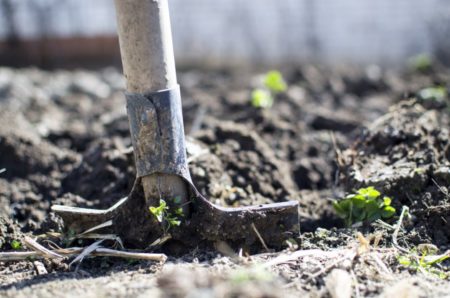

Before digging your garden in the fall, it is important to take into account its features:
- Clayy, loamy areas, as well as land with a close location of groundwater cannot be left without processing. The excavated area, each pore and hole will be filled with oxygen. This will help double the volume of the soil. The soil, enriched with oxygen and carbon dioxide, copes faster with decaying plants, and useful humus is formed. After planting plants in spring, they will be more resistant to frost, drought, their root system can penetrate into the deep layers of the soil.
- If the soil is light, loose, saturated with humus, it is better to shallowly loosen it with sand, but not dig it up. Digging is needed only in weed-contaminated areas. It is impossible to regularly resort to deep plowing, since the procedure negatively affects the structure of the soil.
You need to plow before the onset of cold weather, and the appearance of the first snow. If it is plowed together with the soil, the process of heating the soil in spring will slow down significantly. You also need to be in time before the rainy season, otherwise the top layer will become unnecessarily dense.
Is it necessary to dig a garden in the fall: the pros and cons of digging
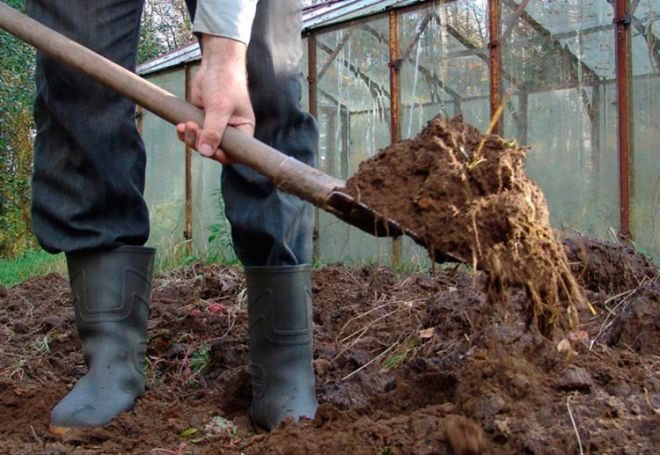

Today, you can often come across the opinion about the uselessness of digging the soil in the fall. Often in modern specialized literature on agriculture, you can read that it is necessary to dig up a vegetable garden in cases of extreme necessity. And it is desirable to do without this procedure at all. But many experienced gardeners know that this approach can even harm the plantings. So is the autumn digging of the garden necessary? It is worth considering this issue from all sides.
What does the cultivation of the land give in the fall?
First of all, this simplifies and facilitates planting work in the spring. Even those who are against such an event agree with this. After all, when the last vegetables are collected, the cold weather is still quite far away. And if the weather is warm, then the beds are overgrown with weeds. This means that if you do not remove them now, then next season it will be more difficult to deal with the dominance of weeds. What other advantages does this procedure have?
The soil becomes softer and more loose;
The land cleared of weeds is saturated with oxygen and moisture;
In the spring, such soil warms up faster than untreated soil in the fall;
During autumn cultivation of the soil, a good water-air regime is created for plants;
The thermal properties of the soil are also improved in spring, the land will ripen faster for planting. The pluses of the autumn work include the fact that the remains of the stems, stones and other debris were removed ahead of time. All this makes it easier to work in the garden in the spring. In addition, tillage in autumn is usually carried out with a turnover of the soil layer. It helps fight pests and disease-causing bacteria. After all, they hibernate in the upper layers of the soil. And after digging up the earth, some of them will simply die from freezing by the spring.
Dependence on soil type
However, you should not go to extremes, because whether the soil needs deep digging in the fall depends primarily on its type. An area with clayey or loamy heavy soil, where groundwater lies close to the surface, will not do without autumn cultivation. The fact is that all the pores and holes formed during digging in the fall are filled with air. And the treated soil increases its volume by almost 2 times. In loose soil, due to carbon dioxide and oxygen, plant residues decompose faster, and humus is formed. In such a soil, plants can more easily tolerate frost and drought, and their roots penetrate deeper into the soil.But initially light and loose, sandy and humus-rich soils are advised to simply loosen deeply in the fall. On a plot with such land, it is recommended to dig up only heavily contaminated places, removing the roots of weeds. Frequent and deep digging of such land is not useful. This can destroy the structure of the soil. It is best to cultivate the land in autumn before the onset of cold weather and before the snow falls. Because if you bury it in the ground, it will slow down the heating of the soil in the spring. And, most importantly, be in time before the period of prolonged rains, otherwise you can achieve the effect of compaction of the earth.
What is the best way to cultivate a vegetable garden in the fall?
This again depends on the type of soil. Deep autumn digging of a vegetable garden on heavy soil is carried out with raising layers of earth. You do not need to turn them over, but simply carefully shift and remove the roots of the weeds. It is better not to level the soil, leaving rather large lumps of earth, they will not allow it to crumble during rains. In addition, due to this, the soil will freeze to a great depth. This will not only make it easier to control pests, but after such rough cultivation, the land will better absorb autumn rainfall. Such a surface will keep moisture and snow well. The bottom layer of the soil will be a breeding ground for plant roots. But the upper part, if you put it on the bottom of the furrow, will be enriched with various useful substances. When one row of soil has been processed, proceed to another. The main thing is that the distance between them is not too wide, otherwise the layer of excavated earth will be large, and the soil will not be saturated with air. With shallow cultivation of light soil in the fall, it is worth starting with loosening immediately after harvesting. This is how the growth of weeds is provoked, which will appear on the beds in two weeks. They are easy to handle with an ordinary hoe. Vegetable tops and other herbs can be laid in trenches for warm beds.
Fertilizing while digging
The procedure for digging a vegetable garden in the fall is a good opportunity to fertilize the soil with various mineral and organic compounds. They will saturate the lower soil layer with useful substances, where the plant roots are located. Organic matter, for example, compost, manure, can only be applied where the growing of vegetable seedlings is planned. Before the time of their planting, it will have time to grind well in the ground. It is quite acceptable to add fertilizers with potassium and phosphorus to the soil. They are not washed out of the soil for a long time, and the earth will be nourished throughout the winter. Ash, superphosphate can be added. What other nutrients can be added to the soil during processing in the fall?
Wood sawdust moistened with urea solution.
Wood decomposes slowly in the soil, while consuming a large amount of nitrogen;
Grass or tops embedded in the ground in the fall will be used as green manure;
By burying the leaves in the fall to a decent depth, you can increase the fertile soil layer.
However, if in the summer the plants were sick with fungal diseases, then it is advisable to remove all the leaves from the site and burn them.
According to: Nash Gazon
When to dig a garden in autumn
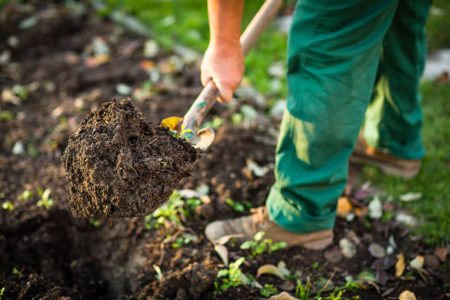

It is necessary to start plowing the land before the cold weather, usually this is done immediately after harvesting the crops grown. Fertilizing the soil during this period will have an impact on the next year's yield. Spring plowing is in no way capable of replacing autumn plowing. It should end before the season of heavy rains, since after them it will be impossible to loosen the soil, especially if it is a clayey area. The ideal period to start digging is the end of September and the beginning of October.
First, it is better to use a rake and slightly loosen the soil after harvesting the previous crop. This will provoke weed germination. After a couple of weeks, all the seeds will germinate and you can start the usual digging with a shovel.If you skip a deep plow, then the weeds will still have to be removed, only this will require more effort.
How best to dig
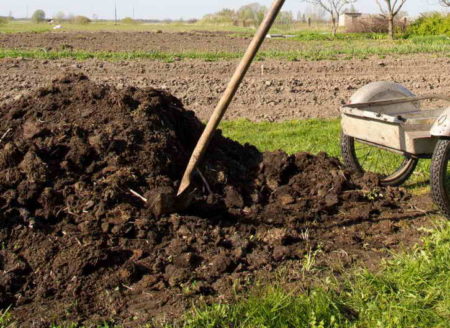

The digging method directly depends on the crop grown next year. For carrots, potatoes, beets, melons, pumpkins and parsley, you need to dig about 30 cm.In the areas for tomatoes, peppers, legumes, cucumbers and radishes, a depth of no more than 10 cm is sufficient.
It is better to simply shift the soil rather than turn it over - this allows you to preserve the local microflora. Found weed roots must be removed immediately, in no case should they be buried. Rocky, hard soil is dug up onto two bayonets of a shovel, turning the soil over - the method is used in extreme cases.
For digging, you can use:
- a shovel can be used in a small area. It is suitable for all types of soil, but requires a lot of effort and time;
- the pitchfork is suitable for obtaining a soft structure, which is considered best for young crops;
- the cultivator allows you to quickly loosen the area, destroy weeds.
Processing the site with a walk-behind tractor
When using a walk-behind tractor, it is recommended to replace the cutter with a tool with a wedge-shaped, oval or flat edge. Large lumps will remain on the cultivated land, they cannot be destroyed - after the onset of rains, the necessary saturation with moisture and oxygen will not occur. In addition, large boulders help to keep the snow out. Upside down soil is saturated with nutrients, which has a beneficial effect on future yields.
How to clean an overgrown area
In accordance with the drawn up plan, the main points of development of the overgrown area are started:
- First, they clear the area from surface debris that can be collected on their own - stones, sticks, branches. This work does not require significant physical effort. All unnecessary collected waste is piled into 1 - 2 small heaps. It is desirable that there is a vehicle access to this place.
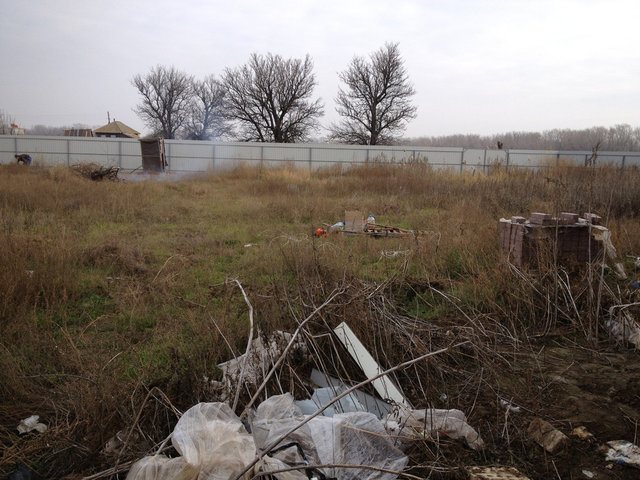

Important! You cannot bury garbage, even small ones, into the soil. This will interfere with the development of the root system of the plants planted in the future.
- To remove dry shrubs in an overgrown area, a significant part of the branches is cut with a garden pruner without affecting the central ones. Then they dig in the roots and uproot the plants. It is not enough to just cut the bush with a saw. After some time, young shoots will turn green on it. All cut and uprooted dead wood parts are taken to the landfill. This way you can estimate the amount of work done and make room for further weed control.


- Do not cut down all the trees in an overgrown area. Some of them are better left. This will help create shading conditions for those crops that will be planted in the future. And in the general landscape design of the area being developed, even trees with a beautiful crown will look appropriate. Thin specimens are cut with an ordinary ax, thick trunks are cut with a saw. To remove tall trees, it is better to consult a specialist. The leaves from the branches can be harvested, dried and then used as an organic soil fertilizer.
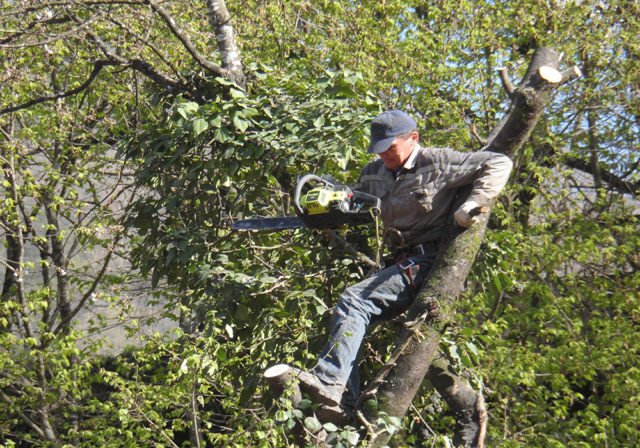

- Uprooting stumps from an overgrown area will be more convenient if their height does not exceed 1 m. Such objects are dug in, the roots are chopped off and taken out to the surface. Then each stump is swayed and pulled out of the soil; if there are a lot of them and it is not possible to pull them out manually, you will have to hire a tractor to pull them out of the ground using a winch. This method is quite expensive. You can also use a crusher. This is a safe option, but not very effective, since it does not remove all roots, and some still remain in the soil. If the owners of an overgrown plot have enough time and in the next year or two planting fruit and vegetable crops is not included in their plans, you can use longer-term methods of removing stumps.Wet saltpeter is poured into the hole made with a drill, and it soaks the entire stump for a year: later it will only have to be set on fire so that it instantly burns out to ashes. This place can only be used for planting the next year. There is another exotic way to remove a stump from an overgrown area. If you plant honey mushrooms on it, the mycelium will destroy it for several years, and at the same time, throughout this time, please the owners with a fresh harvest of delicious mushrooms.


After completing the first four points of the plan for clearing the overgrown area, they proceed to the next, no less important and voluminous stage - the removal of thickets from grass and weeds. Ways to combat them are divided into chemical, folk and agrotechnical.
How to clean an overgrown summer cottage with chemicals
The use of chemical herbicide preparations effectively removes all unnecessary vegetation on the site. Many summer residents and gardeners are increasingly resorting to this method in order to save time and effort.
The advantages of treating an overgrown area with chemicals:
- guaranteed disposal of all types of weeds;
- the ability to clean large areas;
- drugs do not accumulate in the soil and are removed from it within 2 weeks;
- selection of alternative chemicals, taking into account the individual characteristics of the territory.
Depending on how the herbicides affect the weeds, the preparations are systemic and contact. Systemic - when hit on a plant, they quickly penetrate into all its cells, simultaneously affecting the root system and the ground part. Contact - affect only the place of impact.
According to the direction of action, herbicides are divided into selective, destroying only weeds, and continuous, from which valuable crops can also suffer. The latter are used in cases where the soil in the overgrown area is very hard and it is impossible to dig it up with an ordinary shovel. Weeds with a perennial root system are also an obstacle to the development of the site with sparing methods and the basis for the use of such effective preparations as Arsenal, Graud bio, Tornado, Hurricane Forte, Roundup. These products get rid of weeds the first time. In rare cases, re-treatment with a dose increased by half of the amount indicated in the instructions is required.
The main disadvantages of treating an overgrown area with chemicals include:
- destruction of not only weeds, but also cultivated plants;
- the possibility of re-germination of plant pests, since herbicides do not destroy seeds;
- the need to observe caution and use personal protective equipment, due to the high toxicity and the presented danger to humans and animals.
Weeds must be destroyed before the plants enter the flowering phase. For the treatment of an overgrown area with chemicals, a hot, windless day is chosen. It is desirable that, according to forecasts, precipitation is not planned within the next 10 - 12 hours.


The weeds treated in accordance with the instructions turn yellow, and after 2 weeks they die along with the root system. Then they must be collected and burned. The resulting ash cannot be used as fertilizer.
Important! If, after the first treatment with chemical preparations, it was not possible to destroy the growing weeds in full, the repeated procedure can be carried out only after 4 - 5 weeks.
A few recommendations will help you avoid some of the main mistakes of removing weeds from an overgrown area using green manure:
- Be sure to strictly observe the dosage indicated on the drug packaging. Incorrect proportions can lead to soil contamination.
- In small overgrown areas with plantings of berry and fruit plants, it is better to do without the use of weed killers.Their use is justified on large plantations intended for planting crops such as pumpkin, potatoes, corn.
- Digging up the soil before spraying will slow down the penetration of drugs.
- The use of the same chemicals reduces the effectiveness of the treatment of the overgrown area.
It is possible to plant fruit and vegetable crops on the treated area only next spring, after plowing it up beforehand. And in order to enrich the soil with useful elements and substances during this time, it is recommended to sow green manure, which will help improve the structure of the soil.
How to tidy up an overgrown area with folk remedies
Experienced summer residents and gardeners know many unconventional, but effective ways to destroy weeds using the available tools available in every farm:
- Waste paper and rotted manure. Compost, humus or chicken droppings are evenly distributed over the entire surface of the overgrown area and covered with newspapers 5-7 layers thick. Newspapers can be replaced with thick cardboard. A layer of compost mixed with manure is poured on top. In newspapers, you can make holes and plant seedlings in them, for example, tomatoes, beets or strawberries. At the end of the season, the owners of the overgrown plot will receive not only the harvest of the planted crops, but also the weed-free soil, enriched with vitamins and microelements.
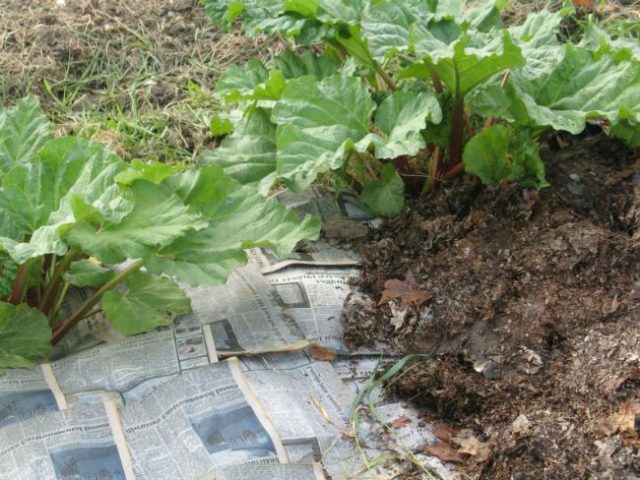

- Black film. The entire surface of the overgrown area is covered with an opaque material. In summer, in hot conditions, such a temperature is created under it that not a single weed can survive. At the end of the season, the film is removed, the soil is dug up and allowed to rest. Plants can only be planted next year. The method is very effective and even kills perennial weeds.
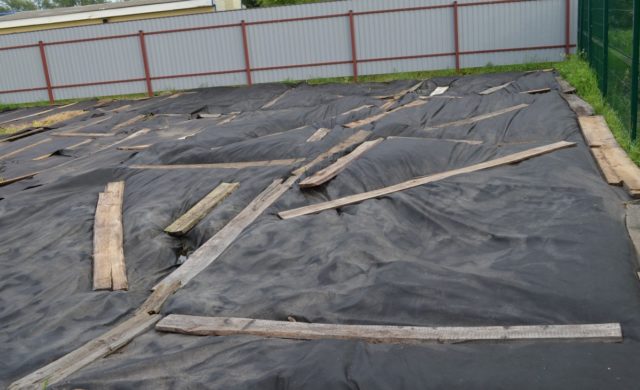

- Alcohol. A month before sowing, the soil is treated with ethyl alcohol diluted with water in a ratio of 150 g of vodka per bucket. Under the influence of an alcoholic solution, weeds begin to grow intensively, after which it is enough to weed them out.
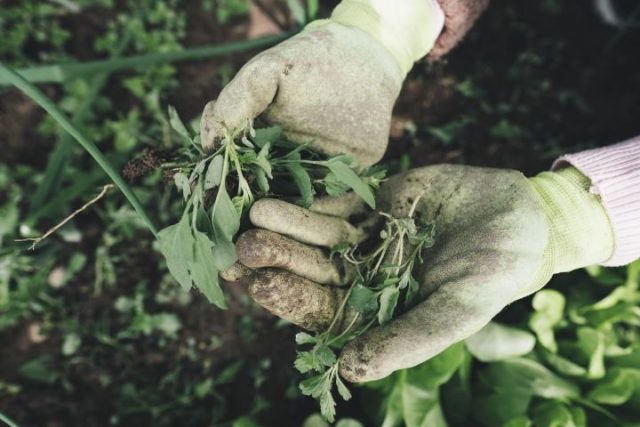

- Blowtorch. Before the germination of cultivated plants, all weeds are burned with a sliding flame of a soldering iron, which does not linger in one place. After processing, the area must be watered.
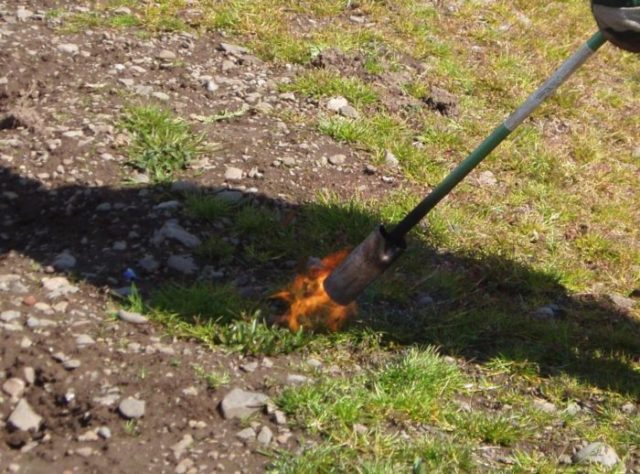

- Soda. Spraying weed clusters with a strong soda solution will reduce the intensity of their growth.


- Herbicidal soap. A composition obtained from grated laundry soap and the same amount of vinegar and salt is sprayed on the ground part of weeds.
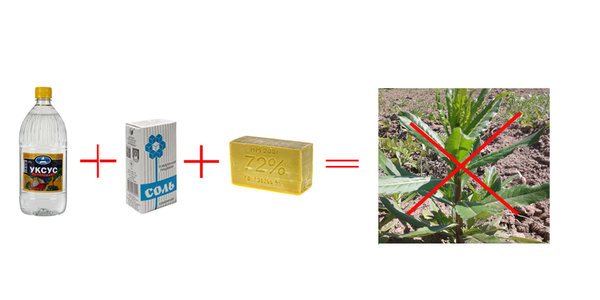

You can spray weeds from a spray bottle with a product prepared at home from available tools:
- 2 tbsp. water;
- 2 tbsp. vinegar;
- 30 g of alcohol;
- 2 tsp dishwashing detergents;
- 1 pack of citric acid.
When spraying the product, care must be taken so that it does not get on crops.
How to develop an overgrown site with agrotechnical measures
Using available gardening tools and tools, you can just as effectively free the overgrown area from weeds. True, some agrotechnical methods involve the use of certain physical efforts, which is why they are not very popular with gardeners and gardeners:
- Digging the soil. After all the grass has been harvested, it is necessary to mechanically cultivate the land, preventing the possibility of re-growth of weeds. In order to effectively dig up an overgrown area, the soil is turned over with a shovel, earth clods are crushed and fertilized with organic compounds. Usually, one digging to the depth of one shovel bayonet is enough. In rare cases, a two-tiered digging is required.
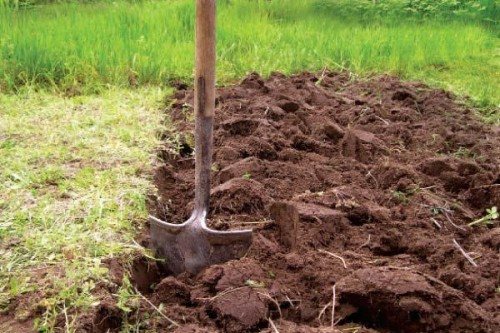

- Planting cabbage, bush beans, potatoes. The distance between plants should be no more than 10 cm, between rows - no more than 30 cm. The leaves of these plants will create shade and prevent weeds from growing. Periodic hilling of the beds will also contribute to their effective removal. Bean tops can be added to compost after harvest. The site should be processed with a hoe.
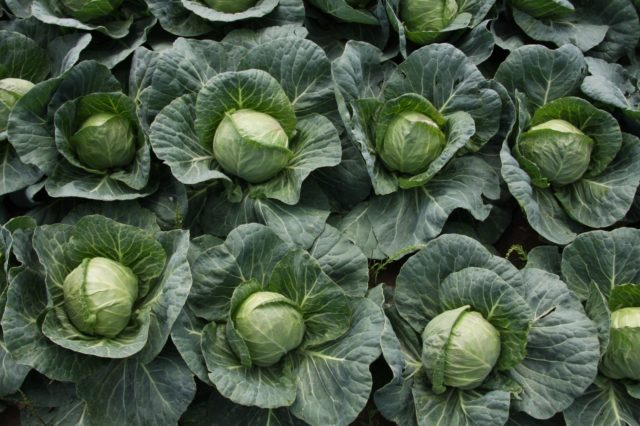

- The use of green manure. Rye, rapeseed, mustard do an excellent job with weeds. In autumn, green manures are cut and dug up, thus creating an excellent fertilizer for the soil. In early May, sunflower seeds are sown as thickly as possible. By building up the root system, sunflowers will take food from the weeds and they will not be able to survive. With the onset of autumn, the sunflower crop must be mowed, cut into pieces 20 cm long and distributed over the site. Once decomposed, the green manure will fertilize the soil and prepare it for planting new crops in the next season.
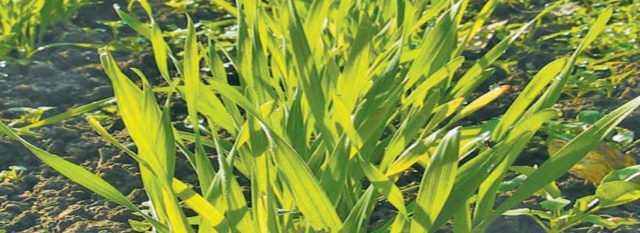

- Mulching of row spacings. The cut grass, lined with a layer of 5 cm between the rows of cultivated plants, will not allow weeds to germinate.
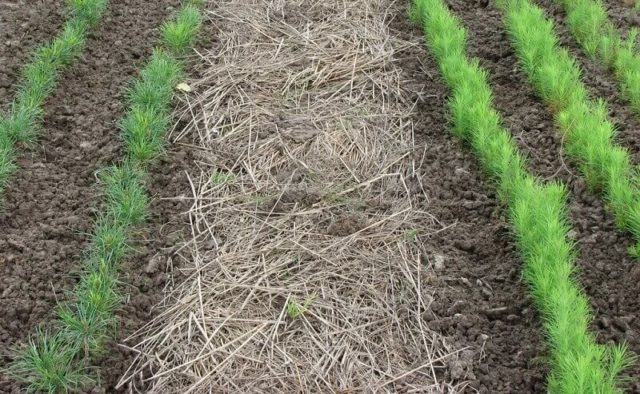

These methods have proven to be effective and do not have a harmful effect on the environment. Thanks to this, they are widely used by owners of garden plots.
Application of mineral fertilizers in autumn
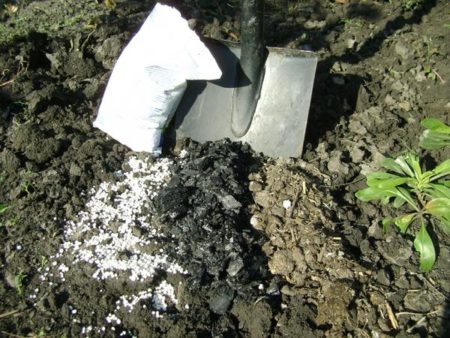

Gardeners, when they begin to dig up the plots, apply fertilizers. Organic matter must be distributed over the beds where it is planned to grow cabbage, cucumbers and seedlings. The amount of fertilizer should not exceed 1 bucket per sq. m. Used compost, manure. Fertilizers of mineral origin are allowed for all crops. The soil for mineral compositions should be dug up at least 20 cm. Liming is carried out if the soil is acidic.
Not everyone succeeds in completing all the work before the first cold weather. After harvesting cabbage, parsnips or celery, the tops do not need to be taken out of the garden, it is worth finely chopping it with a shovel and digging it in. This will become organic humus that will benefit your plants in the spring.
Value by type of cultivated crop
The dreamed land plot is associated with the fruits of human activity in reality, as well as making a profit and his material condition. When interpreting night dreams, it is necessary to take into account what was planted.
Dream meanings by type of crop grown in the land:
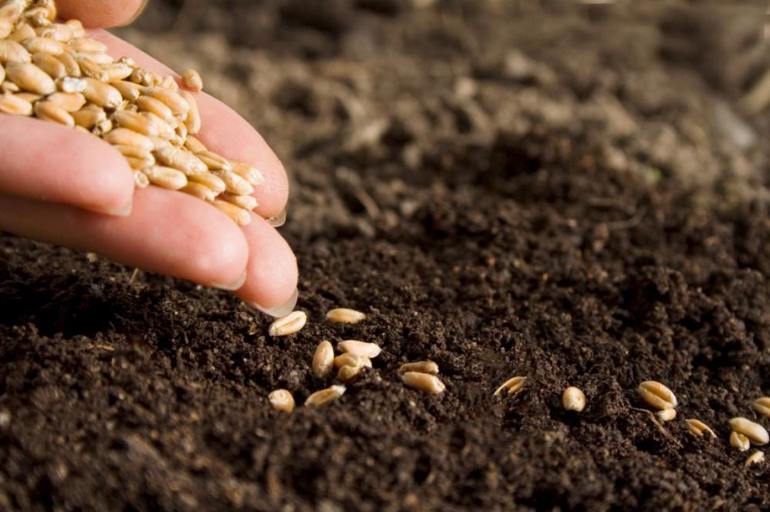

- Potatoes. Large fruits mean good luck and success in work and personal relationships, and small ones mean trouble, because of which a person will shed tears.
- Planting tomatoes or peppers - life will soon become pleasant and interesting.
- If it was eggplants, cucumbers, carrots or other crops with long fruits, you can wait for the birth of a son.
- Round-shaped vegetables and berries promise the birth of a girl.
- Planting greens or cabbage portends empty beginnings.
- Garlic dreams of the development of independence.
- Planting onions in a dream is considered a negative sign. In reality, a person will experience powerlessness, hatred, envy and other negative emotions.
- Planting a tree in a dream usually predicts new meetings and acquaintances. If it is a pear or lemon, in real life the betrayal of the second half awaits.
- Planting flowers in a greenhouse or conservatory is a harbinger of making your cherished dream come true.
If in a dream a person sowed seeds, this promises new beginnings or an exciting journey. In some cases, the vision predicts good news. For a woman, night dreams portend conception. Planting seedlings in the ground means that a person should accustom his children to independence. Sometimes such a dream speaks of the beginning of the implementation of plans.
You also need to pay attention to the result of planting the plant. A dream in which weeds and grass have grown instead of culture means that in reality a person's plans will not come true. If in night dreams the cultivated plants are flooded with water, in reality you should expect trouble.
Do I need to dig up the ground in the greenhouse in the fall
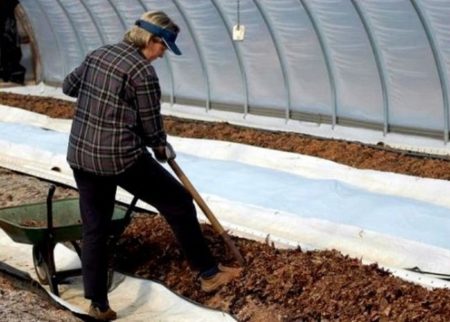

Experienced gardeners are advised to completely replace the layer of fertile soil annually. To do this, the upper part by 10-15 cm must be removed and new land brought in. Not everyone understands why it is necessary to do this. So, it will turn out to increase productivity, reduce the risk of developing diseases of the soil and plants.Even with the understanding of the importance of replacing the soil, not everything turns out to be done. In this case, digging up the beds becomes the best option. All remaining plant roots and insect larvae must be carefully selected.
During the same period, gardeners prefer to apply fertilizers. Its type depends on the plants that will be grown in the greenhouse. Most often used:
To improve the fertility of the soil and its structure, gardeners planted mustard in the greenhouse after harvesting the entire crop. It not only allows you to raise the productivity indicators of other crops, but also effectively copes with the harmful microflora that is in the soil.
Varieties of miracle shovels
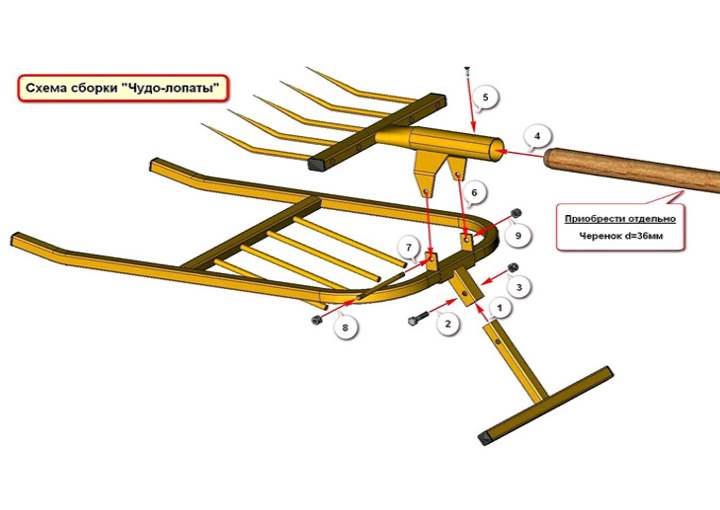

Excavator. This ripper is a device with two shank forks and one ripping element, on which there is a special support under the foot. The two cuttings in the upper part are connected, which makes it possible to adjust them to the desired height. Thanks to this double handle design, the ground is lifted and dropped by lightly pulling the handle to its side, without any effort on the back.
Mole, Mole-B, Plowman. Here, too, the basis is the principle of two pitchforks, when one moves through the other. With their help, non-turnover loosening of the soil is carried out.
Substitutes for shovels Legkokop and Digger. These devices are designed for crumbly soil. Equipped with a wider fork-shaped working part with a 60 cm grip, which is located on the cutting part. In the upper part of the bayonet, there is a crossbar designed for two-handed operation. By foot pressure on the lower bar, some forks move towards others, which break large clods.
These devices are heavier than a shovel, but in the process of digging they do not need to be lifted from the ground, you just need to rearrange it to another place and press your feet into the ground. In addition to digging, they can also harvest root crops.
Tornado. This shovel is represented by a metal rod, at the top of which there is a movable handle. The pins with curved teeth are located at the bottom. The device is installed vertically to the ground and by turning the handle a reverse movement is made, in which the teeth are driven into the soil. When working, only the arms are involved, the back remains in a straight state, the efforts are minimal.
Also, a substitute for a shovel can be such inventions as rotary miracle pitchforks, Fokin's plane cutter, and a hand cultivator.
When is it better to plow a vegetable garden: in spring or autumn
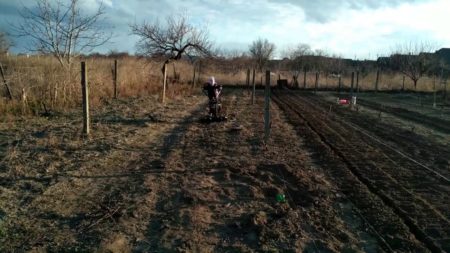

Gardeners have different opinions about when it is better to dig up the beds. Experienced experts explain why such a procedure should be carried out in the autumn. This will greatly benefit the soil. It is imperative to dig up the beds in those areas where the soil itself is bad. When the soil turns over, weeds freeze during the winter, pathogens die, which lead to diseases of crops grown in the garden. Digging annually in the fall months will increase yields, and there will be fewer problems during cultivation.
If in the fall it was not possible to dig up a garden, you can do this after the snow has completely melted and the earth becomes soft, ready for the upcoming loosening. It is performed taking into account a number of rules:
- the soil should not be frozen;
- it is necessary to dig up the site with furrows;
- while loosening, you need to carefully break up the lumps;
- in spring, it is best to process the garden with a shovel. It will help to loosen the soil well and break up the forming lumps.
Tips for novice gardeners
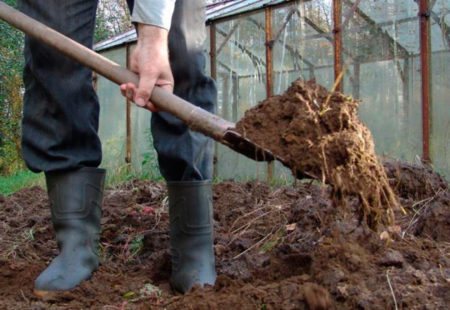

People who constantly work on the land know that digging the soil to the same depth every year leads to the formation of a compacted bottom layer. To avoid this, once every 4-6 years, you need to carry out a 2-tiered digging of the soil.
- It is necessary to dig to the full depth of the shovel bayonet and return the raised earth to the hole.
- This will saturate the soil with the necessary substances.
- Weed seeds will be milled until spring.
- The land needs to be well cultivated. Do not dig too wet or dry soil.
- The shovel should be kept upright, picking up a small amount of soil.
In the fall, the garden needs to be dug up with 40-centimeter furrows. First you need to cover the soil with compost, manure. First, the first furrow is dug, followed by the second, which buries it. So, all the nutrients will be in the soil. Organic fertilizers can be applied to the dug furrows.
Autumn fertilizers for digging
Based on what has grown in the beds in the current season and is planned in the future, different fertilizers are applied. Each plant removes a certain set of minerals from the soil. In order not to deplete the soil quickly, crop rotation must be observed. Alternate pumpkin plants with nightshades, the latter with roots and herbs, then the vegetables will have enough nutrients for a long time.
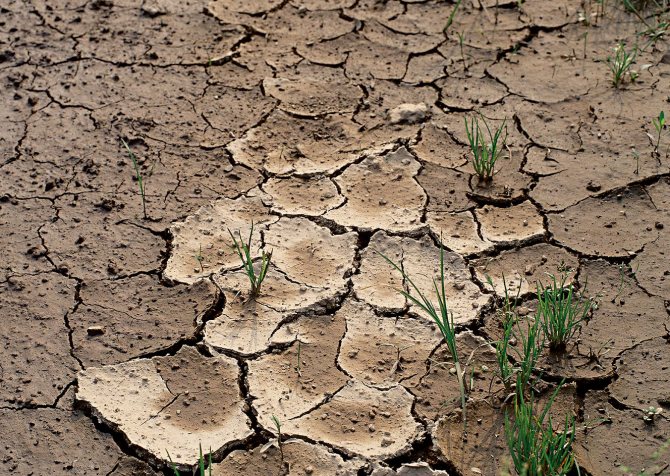

To deplete the soil can also lead to the annual too deep moldboard plowing.
Organic
Autumn is the only time when fresh manure can be added to the garden land. But it is reasonable if cucumbers, zucchini or pumpkins will grow in the garden next year. In other cases, the earth is filled with humus, because nightshades and root crops cannot stand fresh organic matter.
Manure is applied once every 3 years. Doses depend on fertility; on poor soils, it is permissible to double the rates. Typically, 1 m2 of garden is filled with rotten to choose:
- mullein - 5 kg;
- horse manure - 3 kg;
- chicken - 1 kg.
Animal waste can be replaced with compost: 5–6 kg per 1 m2.
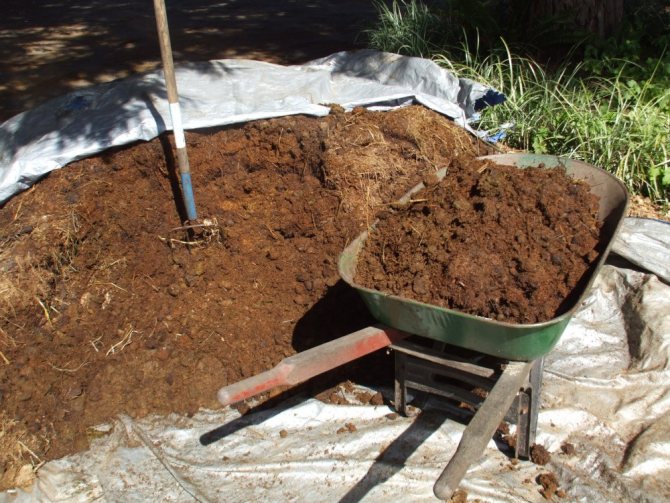

Rotted manure contains no ammonia that burns plant roots
Mineral fertilizers
In the fall, long-dissolving chemicals are used so that they do not wash out of the soil until spring. These are potash and phosphate fertilizers. When making fertilizers containing nitrogen, the garden is dug up before frost in order to preserve all the substances until the spring planting of vegetables.
Ammophos - nitrogen-phosphorus fertilizer is used in the beds where it is planned to grow potatoes or beets. For 1 m2 for digging, 20-30 g (1 matchbox) are consumed. Effective in arid climates.


Classic ammophos contains 12% nitrogen and 52% phosphorus
Superphosphate is a universal phosphate fertilizer suitable for all vegetables. Usually, simple superphosphate is used for digging, as the cheapest. Depending on the fertility of the soil, it is recommended to apply from 30 to 50 g per 1 m2 (1-2 boxes).
Double superphosphate is highly soluble in water, so it is better for them to feed the plants during the summer.


Superphosphate contains a lot of phosphorus, which is necessary for the development of a good root system in plants
For fruits and roots to be tasty, potassium is needed, but it is quickly consumed by plants. Its deficit is compensated by the introduction of 1 m2:
- 20-25 g of potassium sulfate (1 box of matches);
- 20-40 g of potassium salt (1-2 boxes);
- or 10–20 g of potassium chloride (from 1/2 to 1 box).
The last two agrotuks contain chlorine, so they do not fill the beds with large doses of them, where crops sensitive to this substance are planted: nightshades, cucumbers, radishes, onions, garlic. Only beets, carrots, cabbage and celery respond well to the autumn application of potassium salt. Sunflower and cereals react well to potassium chloride. Since potash fertilizers acidify the soil, a month before their application, it is deoxidized with dolomite flour or ash. This applies to initially acidic soils.
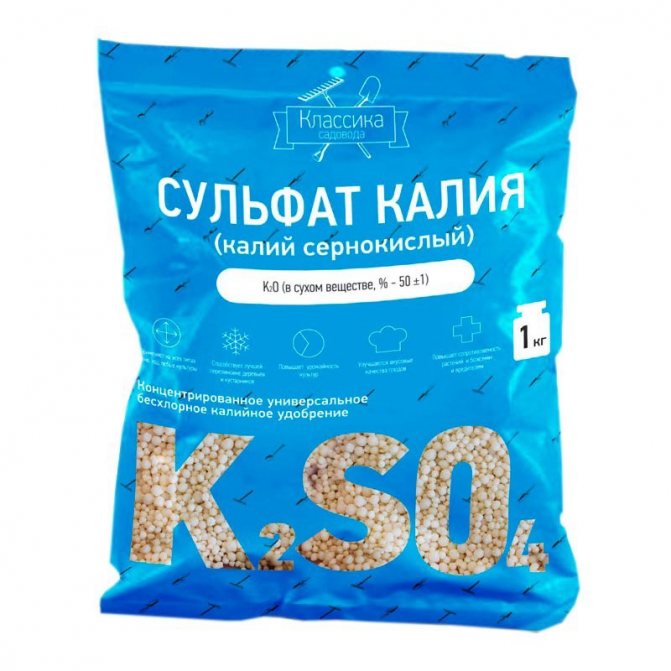

Potassium sulfate - potassium sulfate is safe for all crops
Instead of the listed potassium-phosphorus fertilizers, ash is often used: 5-10 glasses per 1 m2.
Fertilizers for autumn - video
I had to grow vegetables on both sandy and loamy soils. In the first case, I applied manure or compost every fall to increase the fertility and retention properties of the soil.But the best result was given by adding dry clay to the beds, the yield increased significantly. Mineral fat is quickly washed out of such soils, so I introduced them in the spring. Only tomatoes, potatoes, carrots and daikon were good for me. Now I grow vegetables on loam, where I add humus every 4 years. Every autumn I alternate superphosphate and ash. Finally, peppers, melons, cucumbers grow well with me, because on sandy soil I never managed to get a decent harvest of these crops.
With intensive farming, it is simply necessary to fill the garden with nutrients in the fall. Humus is applied every 3 years, and phosphorus and potash fertilizers are applied annually. Simple superphosphate and potassium sulfate are suitable for any vegetables; for beginner gardeners, this is the best autumn set.
In summary: to dig or not to dig
Digging the soil allows you to destroy weeds, evenly distribute the fertilizers that have been applied. In the process, pests and underground rodent burrows will be destroyed. This helps to increase the yield in the garden. You can choose manual or mechanical processing of the site. In order for the digging to be successful and go for the good of the earth, it is worth listening to the advice of specialists and experienced gardeners.
Adding an article to a new collection
After a busy summer season, I want to relax as soon as possible and, if possible, reduce the list of works. One of them - digging the land in the fall - was recently carried out by all gardeners and was considered very important.
And now more and more often the question arises: is this really a necessary procedure, is it worth spending time and effort on it, or can you do just a spring digging? So, let's finally find out whether it is necessary to dig up the garden in the fall and understand all the intricacies of this work.
Preparing the beds in the fall for the new season is one of the most important conditions for obtaining a rich harvest. During the winter, the soil is saturated with minerals that were brought in for digging. Snow quickly saturates the beds with moisture, while the dug soil itself does not compact. As a result, in the spring it is much easier to carry out preparatory work before planting. Time and effort are significantly saved. But that's not all the advantages of digging!
Why dig up the ground in the garden - the advantages of the procedure
Have summer residents been mistaken for decades, starting to dig the earth with a shovel in the fall? It is fair to say no. Digging has many advantages, some of which are quite obvious, while others are not so noticeable, but they also make a useful contribution. So, digging is useful in that:
- during work, it is easier to apply the necessary mineral and organic fertilizers, deacidify the soil, the effect of these procedures will increase many times;
- weeds will not get a chance for free wintering, and their seeds will not get further development, due to the fact that they will be deep in the soil;
- garden pests and their larvae, pathogenic bacteria, once on the surface, quickly die from cold, wind or exposure to chemicals, and birds do not mind eating insects;
- the soil becomes looser, water and air permeable, during the winter it is more easily saturated with moisture and does not become too compacted, and in spring it warms up faster;
- it becomes possible to clear the site of weeds, leaves, stones and other debris, which creates many problems in spring.
What is good about autumn digging
Digging of the garden is especially necessary in the fall for heavy, uncultivated clay soils. At the same time, work is performed on other types of soil. Autumn digging of the garden has the following advantages:
- With deep cultivation of the land in the garden, all pests rise upward. Colorado potato beetle, wireworm, rodents, cabbage, caterpillars - all of them will be eaten by birds or die from cold, wind, sun.
- At the time of the autumn digging, weeds sprout under the still warm daytime sun. The hardened crops then die in the first frost.The non-germinated weed dies from the wind, cold even at the seed stage.
- During the autumn digging, the remains of cultivated plants go into the ground. They simultaneously fertilize the soil, work as a baking powder.
- In well-loosened soil, nitrogen-fixing microorganisms begin their active activity. They enrich the earth with all the forms of nitrogen it needs.
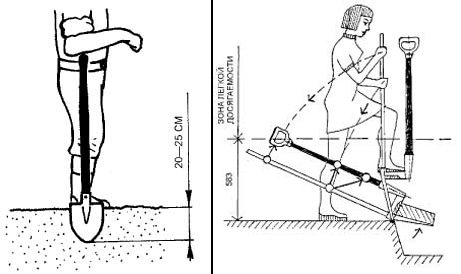

How to dig with a shovel correctly
- When digging a garden in autumn, you form the best retention of moisture in it (precipitation in the form of rain and snow). In the spring, such land, warmed by the sun, will be more convenient for plants. It will create a kind of greenhouse effect for them.
- The ability to apply the necessary fertilizers to the soil, which will completely rot and rot during the winter. Most often it is wood ash, green manure, sawdust moistened with urea.
Interesting: The use of wood ash in the garden
Important: when digging a garden in autumn, it is important to remove all fallen leaves from it. It is a mistake to think that it will become a good fertilizer. Often, the foliage can contain diseases and pests, which will begin their harmful activity in the soil.
In extreme cases, you can then cover the dug-up garden with fallen leaves. In the spring, it will need to be removed from the beds.
And the most important plus of the autumn digging of the garden is that by performing such work on the eve of winter, we make it easier for ourselves to carry out spring soil cultivation before planting. In warmer months, it will be enough to just slightly loosen the ground and form the beds.
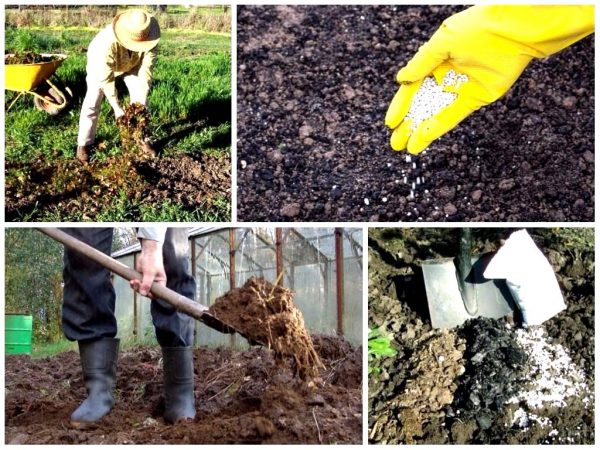

Do I need to dig up the ground in the fall in the garden - the disadvantages of digging
And now let's consider what are the disadvantages of digging the soil, why the adherents of organic farming disliked it so much.
The soil is home for many living organisms, and each of them has its own place in this "kingdom". When digging, not only harmful inhabitants appear on the surface, but also useful ones, those thanks to which the soil retains its fertility. By depriving the beds of "good" bacteria and insects, we thereby impoverish the soil. And, alas, it is not easy to restore soil fertility.
There is also the possibility that weed seeds will still survive under the soil and overwinter safely until spring. In addition, with deep and frequent digging, a less nutritious soil layer rises to the surface, the structure of the soil is disturbed, and it loses its physical properties.
And, finally, digging is hard work that has a bad effect on the condition of the back, heart and health in general, if the summer resident is not very physically prepared. Mechanized digging also requires considerable effort and preparation.
No digging - arguments against
Gardeners practicing organic farming believe that deep digging does nothing but harm. Their tool in the fall is a flat cutter and a rake. Yes, they agree that the caked topsoil should be loosened, but no more than 5–7 cm, so as not to disturb beneficial insects and not to swap the places of aerobic and anaerobic bacteria living deep in the earth.
Although biologists do not agree with this statement. Anaerobic bacteria live at depths exceeding 40 cm, so digging beds, even 35 cm, will not be able to change their places with bacteria living in the upper layers of the soil.
According to supporters of light tillage, digging destroys its structure, passages and holes of beneficial insects and earthworms - the main assistants of gardeners. Weed growth, on the other hand, is more active, since they have very productive roots. A rhizome cut into pieces with a shovel is capable of sprouting a new plant from each piece. And the seeds remaining on the surface of the earth will go into the depths and winter safely.
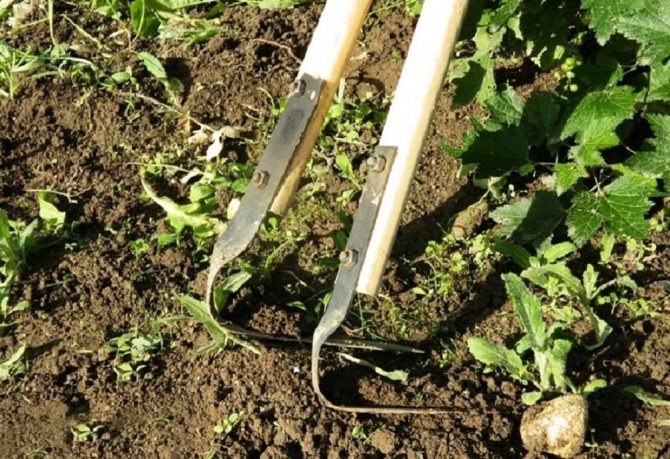

Tilling with a flat cutter is done without turning the soil, which only slightly affects the quiet life of soil inhabitants
When you really need to dig a garden
As you can see, digging has enough pros and cons.But in fact, it all depends on two factors: the type of soil on the site and the climate in your area. In other words, the disadvantages will clearly manifest themselves if you dig where it is not needed at all, and vice versa.
If the soil on the site is heavy, clayey and uncultivated, then digging in the fall is highly desirable. But loose and light soils are easy enough to loosen. Sandy soil only needs spring processing.
In regions with a hot climate, the soil is drier and does not require frequent digging, and in humid and cold regions of the country, this procedure is necessary, because the soil under the influence of natural conditions becomes compacted and becomes unsuitable for growing cultivated plants. And although adherents of organic farming often cite the example of a forest ecosystem, where everything grows by itself without digging and fertilizing, we should not forget that varietal and hybrid vegetables are unable to survive in such conditions. In other words, certain conditions are needed to obtain a crop, which are created on personal plots. Therefore, first of all, observe the condition of the soil and plants.
Dream interpreters
Digging the ground is considered hard work, but this activity helps a person to get food for himself. Such activity is very tiring and takes away strength, but at the same time ennobles and makes you more enduring.
Esotericists give different meanings in their dream books to dig the ground in a dream:


- Freud believed: poking around in the soil means that in reality the sleeper has a rich intimate life with a frequent change of partners, from which he will soon get tired. If in night vision a person dug the ground with his hands, this personifies his desire to find a constant companion.
- Miller's dream book says that dreams portend wealth, which a person will achieve with great difficulty. If, during excavation, a person finds sparkling crystals, minerals or other jewelry, the vision promises happiness. A dug hole with voids means problems in all areas of life.
- Wanga argued that digging soil in a dream speaks of imminent changes, which depend on the type of land. Solid and fertile soil promises joyful events, dry and loose soil is considered an omen of misfortune.
- According to the esoteric interpreter, digging in night dreams symbolizes the dreamer's tendency to look for flaws in himself. He becomes more and more dissatisfied with himself, due to which his self-esteem decreases. A person needs to be simpler and stop being demanding of himself.
- Miss Hasse's dream book says that digging a hole is honest and hard work, from which the sleeping person will not receive any benefit or benefit. In some cases, night vision promises participation in a lawsuit in which a person can justify himself.
- In the Muslim interpreter, a dream foreshadows the imminent onset of a life crisis.
- In Felomen's dream book, such dreams can promise the development of a serious illness that will lead to death.
- The soothsayer Nostradamus believed that a dream with digging a hole in which a person would find jewelry or treasure predicted great luck. Also, a person can come true innermost and daring desires.
The birthday interpreter explains the vision of digging the ground for people born in the first trimester of the year as the need to beware of close contact with people and to trust them less. If the plot was dreamed of by a person who was born between October and December, a lot of money awaits him in the near future.
When is it better to dig a garden - timing
We hope you are convinced that tillage in the fall is still necessary. But not every summer resident knows how and when to dig a garden in order to get a positive effect. This should be done after harvest, when late-ripening crops and all plant residues are removed. It is advisable to carry out the work before the end of October - the beginning of November, depending on weather conditions.It is not worth delaying the work too much, so that the soil does not grab the first frosts. Ideally, if you can finish digging before heavy rains.
Scene
Digging up the ground in a garden clean of excess grass promises good luck and positive results in various matters. If the site is strewn with weeds, the sleeper's efforts will be in vain, and he will not be able to achieve the goal. Also, a vision can mean that a person will discover unlimited possibilities in himself or reveal some kind of secret. If a girl dreamed of such a plot, in reality she will meet an interesting person or even her future husband.


Digging the ground in a flower garden means that in reality the sleeper will receive what he wants in any area of his life.
Working in the garden with dry soil promises trouble, and with wet soil - success and luck.
Digging in a field symbolizes a person's desire to start a risky and unreliable business. He should think several times: is it worth taking on a difficult task.
How to properly dig up the soil in the fall in the garden
Depending on the crop that will be planted next year, the appropriate depth of soil digging is also chosen:
- 25-30 cm (on a shovel bayonet) - for potatoes, beets, carrots, pumpkins, melons and parsley;
- 5-10 cm - for tomatoes, cucumbers, peppers, radishes and legumes.
It is advisable not to turn the soil layers, but to shift them among themselves in order to preserve as much useful microflora as possible. Weed roots are best removed rather than buried. It is much easier to carry out such a digging. But if the soil is very hard and rocky, you will have to do a two-tiered digging with two bayonets of a shovel. And here it is no longer possible to do without overturning the soil layers. But it is worth resorting to such digging only as a last resort.
Use a shovel, pitchfork or cultivator as digging tools.
Shovel. Used in small areas up to 10 acres. A budget option that will perfectly cope with different types of soil, but rather laborious.
Pitchfork. Allows you to achieve a finer soil structure, which is pleasing to young plants, but not always achieved with a shovel. It also takes effort.
Cultivator. The soil quickly becomes loose, plant roots feel great in it. It will save time and effort when working on a large area, but it will not cope with very heavy soils, and it is not cheap.
If the garden requires digging, but there is no way to do it, sow siderates. They loosen the soil to a depth of 2 m, saturate it with useful elements and reduce the activity of pathogenic microflora. And in winter they will keep the snow well and will not let the beds freeze out.
Whether to dig a garden in the fall, each summer resident decides for himself. If you have a heavy clay soil on your site, then it is better to dig it, and if it is loose and light, you can do only with the spring procedure, replacing the autumn digging with deep loosening. To reduce the load on the soil microflora, dig it every few years as needed.
We will be glad if you share your arguments for and against the autumn digging in the comments!
How to properly dig up the ground in the country in the fall
Cultivation of the land in the country is difficult, if it is done by hand. Mechanical digging of a site using a motorboat or a mini tractor significantly speeds up and facilitates this procedure. But in any case, there are practice-proven rules that facilitate the laboriousness of seasonal cultivation of fertile soil.
Basic rules for optimizing labor when digging land in the country manually:
- the shovel must be correctly selected and of high quality: the handle is strong, perfectly smooth, so as not to injure and ash the palms when digging; the bayonet blade should be as sharp as possible to make it easier to enter even a dense layer of soil;
- it is necessary to dig even with a properly sized and high-quality shovel in gloves of the size corresponding to the hands, without rough inner seams, with rubberized palms so as not to slip along the handle of the shovel;
- shoes for digging the ground with a shovel should be selected as closed as possible so that no lumps of soil or pebbles fall; the sole should be firm and thick in order to better protect the sensitive surface of the foot with frequent pressing on the shovel tray;
- the digger's clothing should be matched to the weather to avoid overheating and sweating in the cold wind and not catch a cold; it is better if it will be trousers tucked into high boots or boots, and a jacket that does not hinder movement;
- The technique of digging with a shovel is quite simple, but it requires skill and adherence to some rational rules, non-observance of which will lead to rapid fatigue and a decrease in productivity in this hard physical labor:
- The shovel should be placed as vertically as possible to the ground with a bayonet. Firmly holding the handle with both hands, with a jogging foot, press firmly on the tray of the shovel so that it goes into the ground to a predetermined depth - the entire bayonet or half.
- The vertical position of the shovel allows you to dig deeper into the soil and capture a larger layer of it.
- It is better to dig at an average pace, calculating the forces corresponding to the digging area in the summer cottage.
- Given the laboriousness of manually digging the earth, it is easier to dig bed after bed, taking comfort in the noticeable effectiveness of the work.
Digging land in the country in the fall is a laborious event, but useful in all respects. All of the above rules are designed more for beginners than for experienced gardeners, who, of course, have developed their own techniques and rules for a full program of comfortable, safe and effective work on the land of their favorite site.


